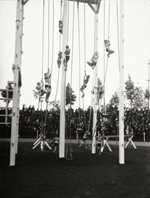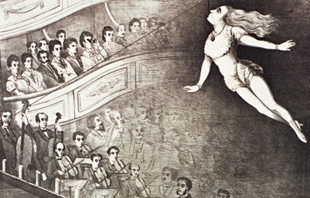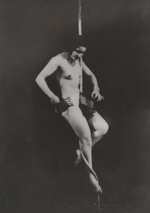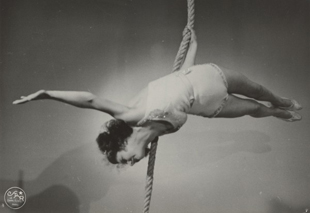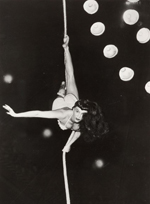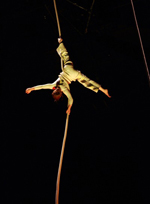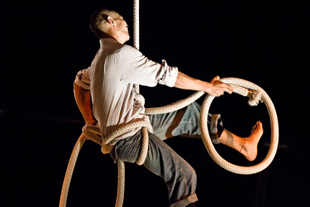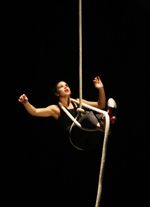by Magali Sizorn
Like the bars, rings and the trapeze, the rope is a reminder of how the circus transforms utilitarian, military and healthy educational physical activities into performance. Rope-climbing was often a part of physical education and gymnastics in the 19th and 20th centuries. In France in particular, Georges Hébert's natural method using a crossbar and stands was much used by generations of school children and amateurs of exercise.
Arm power
The rope, made of stranded cotton or hemp, suspended and vertical, was introduced to circus programmes in the second half of the 19th century. In a performance, climbing in traction were the first rope numbers, also used to reach another aerial apparatus. Then came static and dynamic figures, falls and climbs, which enhanced these exercises of strength.
From the "stop-gap" number to reinventing the apparatus
By the 19th century, it was mainly women who were presenting rope numbers. The great names in the history of the apparatus are therefore female. Emma Juteau and Leona Dare are among the stars of circus shows from 1875-1885 according to Henry Thétard (La Merveilleuse Histoire du Cirque). Leona Dare's success stemmed mainly from her descent of an oblique rope suspended by her jaw. By using a staffe1, an accessory that enabled spectacular rope numbers, acrobats could twirl around, or be suspended by a hand, a foot, or their mouth.
In the 1920s, Lilian Leitzel (1892-1931), an acrobat performing on the rings, carried out a spectacular rope climb to her apparatus, executing an impressive series of "arm rolls." She died after a fall when a snap hook on one of the ring ropes came open. In the 1930s and 1940s, Chrysis Delagrange was announced on postcards as "The world champion in rope climbing." These two artists almost made everyone forget that rope numbers were often additional numbers used as an intermediary while cages were taken down. Or they were used as second numbers for couples, guaranteeing extra income, with the female partner on the rope, and the male partner turning it from the ground.
The rope then, is traditionally a female apparatus and valorised a certain type of femininity. Pierre Bergam, who trained numerous aerial artists at his Trapeze Club in Paris from 1964 onwards, created several rope numbers for Parisian cabaret acts, including in the 1980s, the contortion and twirling act for Laurence Fanon, a willowy dancer from trained at the Opera de Paris.
Higher training and leisure schools, particularly in Russia and Europe, have helped revive this discipline and to encourage men to participate more, by developing new uses and aesthetics. Rope numbers have therefore been appreciated as different, and not merely seen as a supplement, but as a speciality in its own right. A great variety figures has now been developed: climbing, static postures (planks, wraps and scissors), movements (keys, flags and falls), and descents. Rope can be used with other apparatus (ropes, straps and silks for Armance Brown and Bruno Krief's Arts des airs company). In addition, bodies can go slack, ropes can be multiplied (La Part du loup, by Fatou Traoré, in 2007), split (becoming walls of stringy rope in Ariane(s) by the Lunatic company in 2005), and even fluted (Maëlle Boijoux in Gisèle au tuyau, in Plic Ploc by the Cirque Plume in 2004).
Connected to the ground
With neither safety rope nor net, the acrobat certainly experiences ascension and elevation, but rarely lets go of the apparatus. Recently, Rope aerial acrobatic numbers have been performed, mainly by Fragan Gelhker, trained at the Cnac (class of 2009). He lets go of the rope with twists and rotations. The rope however is mainly a prehensile apparatus, close to earthly logic, similar to the Chinese poles. The artist climbs towards the cupola but is always linked to the ground by the end of the rope in the ring, by constraints such as tired muscles, damaged skin and the magnesium used for a better grip on the rope.
Interview
1. Staffe: a leather or solid textile handle attached to the apparatus of held by a pusher and used by aerial acrobats for suspensions.



